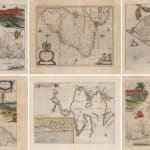![Jan Blaeu, Blaeu's Spectacular Maps of Brazil [set of 6], 1662](https://artlogic-res.cloudinary.com/w_1600,h_1600,c_limit,f_auto,fl_lossy,q_auto/artlogicstorage/themaphouse/images/view/1ade9c7d90de9b2b8556cd4385ce9b5fj/themaphouse-jan-blaeu-blaeu-s-spectacular-maps-of-brazil-set-of-6-1662.jpg) Præfecturæ De Paraiba, et Rio Grande.
Præfecturæ De Paraiba, et Rio Grande.
![Jan Blaeu, Blaeu's Spectacular Maps of Brazil [set of 6], 1662](https://artlogic-res.cloudinary.com/w_1600,h_1600,c_limit,f_auto,fl_lossy,q_auto/artlogicstorage/themaphouse/images/view/777fb0dcd0f791a5129ff5f6a89e68d0j/themaphouse-jan-blaeu-blaeu-s-spectacular-maps-of-brazil-set-of-6-1662.jpg) Præfectura De Cirîiî, vek Seregippe Delrey cum Itâpuáma.
Præfectura De Cirîiî, vek Seregippe Delrey cum Itâpuáma.
![Jan Blaeu, Blaeu's Spectacular Maps of Brazil [set of 6], 1662](https://artlogic-res.cloudinary.com/w_1600,h_1600,c_limit,f_auto,fl_lossy,q_auto/artlogicstorage/themaphouse/images/view/2c952eef5a9fdf369f2006022bb101bbj/themaphouse-jan-blaeu-blaeu-s-spectacular-maps-of-brazil-set-of-6-1662.jpg) Sinus Omnium Sanctoru
Sinus Omnium Sanctoru
![Jan Blaeu, Blaeu's Spectacular Maps of Brazil [set of 6], 1662](https://artlogic-res.cloudinary.com/w_1600,h_1600,c_limit,f_auto,fl_lossy,q_auto/artlogicstorage/themaphouse/images/view/11651cc372a5a4a737848d1ef3a39cb3j/themaphouse-jan-blaeu-blaeu-s-spectacular-maps-of-brazil-set-of-6-1662.jpg) Præfecturæ Paranambuæ pars Meridionalis.
Præfecturæ Paranambuæ pars Meridionalis.
![Jan Blaeu, Blaeu's Spectacular Maps of Brazil [set of 6], 1662](https://artlogic-res.cloudinary.com/w_1600,h_1600,c_limit,f_auto,fl_lossy,q_auto/artlogicstorage/themaphouse/images/view/60a3d26af5c8592fe00f11d6c9504685j/themaphouse-jan-blaeu-blaeu-s-spectacular-maps-of-brazil-set-of-6-1662.jpg) Præfecturæ Paranambuæ pars Borealis, una cum Præfectura Itâmaracâ.
Præfecturæ Paranambuæ pars Borealis, una cum Præfectura Itâmaracâ.
Jan Blaeu
42 x 54 cm each
Further images
These maps impressively detail the Dutch possessions in Brazil. Whilst these colonies were short lived – only existing from 1630 until 1661 – they are powerful in promoting the colony and the Dutch’s magnificent mapping skills, ultimately making the colony’s legacy last.
The Dutch gained control of a large area of North-Eastern Brazil from the Portuguese in 1630 and the Dutch East India Company soon built their headquarters in Recife. Governed by Johan Maurits, scientists and artists were invited to visit and settle here with the intention of promoting migration and trade to their new South American colony.
The Portuguese, obviously bitter with their loss, fought for their former territory. In 1649, during the Second Battle of Guararapes, in a conflict known as the Pernambucana Insurrection at Jaboatão dos Guararapes between the Dutch and the Portuguese – ending in a decisive Portuguese victory.
Eventually in 1654, the Dutch surrendered their control over the area and returned it back to the Portuguese. However, after the First Anglo-Dutch war only four months later in May 1654; the Dutch Republic demanded back the control over New Holland (the name for the Dutch possessions in Brazil).
Under threat from occupation in Lisbon and re-occupation in Brazil, the Portuguese who were already involved in a conflict against Spain gave in to the Dutch demand. Dutch leader Johan de Witt was however more interested in the trading prospects than the territorial claims and arranged for the North Eastern Brazilian colony was sold back to Portuguese through the Treaty of the Hague (1661).
The groundwork for these maps was an astonishing nine-sheet copper-engraved map by geographer and natural historian, Georg Marcgraf, and included illustrations that have been attributed to artist, Frans Post. Marcgraf was a German astronomer, geographer and naturalist and in 1637 he was appointed astronomer for a company due to set sail for the Dutch colony. He was accompanied by William Piso, a physician who had been recently appointed to govern the Dutch possessions in Brazil. Marcgraf and Piso arrived in 1638 and undertook the very first expedition and study into the natural history and geography of the area – researching everything from zoology and botany to astronomy. They co-authored “Historia Naturalis Brasiliae”, an eight volume work published in 1648 for which both of them are best remembered.
This set of six maps were published just one year after the territory was formally returned to the Portuguese. They were published in Amsterdam by Jan Blaeu, who were leaders during a time known as The Dutch Golden Age of Cartography.
The Dutch publishing house was established in 1596 by Willem Janszoon Blaeu, who had studied as a young man under the great astronomer, Tycho Brahe. They originally produced globes and scientific instruments. However, the firm soon expanded into map making and publishing, and eventually became one of the most important and prolific map producers in Amsterdam and recognised throughout the World. In 1623 they published the “Het Licht der Zeevaerdt” an atlas of sea-charts. In 1629 Willem and his son Joan purchased 37 engraved plates from the widow of their rival Hondius and the following year they produced their first land atlas, the “Atlantis Appendix”. In 1635 this was expanded into the “Atlas Novus” a major world atlas in six volumes and many languages, from 1635-59.
After the death of his father, Joan Blaeu embarked on one of the most ambitious publishing undertakings of the 17th Century, the printing of the “Atlas Maior”. This magnificent work was to contain nearly six hundred maps and, depending on the edition, was to vary from nine to twelve volumes. The exquisite engraving, often allied with lovely hand-colouring, make maps from the “Novus” and “Maior” atlases some of the finest ever printed.
The “Atlas Maior” was to be the crowning glory of the Blaeu firm. Tragically in 1672 a disastrous fire swept through the Blaeu printing house destroying much of the stock and most of the copper engraving plates. The following year Joan died and the surviving plates were dispersed. Reflecting their contemporary reputations Willem and Joan were in turn both appointed Hydrographer to the Dutch East India Company and their atlases were frequently presented to foreign sovereigns and potentates by the Dutch government.
Original hand colour. Set of six maps framed.
[SAM3060]
Join our mailing list
* denotes required fields
We will process the personal data you have supplied to communicate with you in accordance with our Privacy Policy. You can unsubscribe or change your preferences at any time by clicking the link in our emails.

![Jan Blaeu, Blaeu's Spectacular Maps of Brazil [set of 6], 1662](https://artlogic-res.cloudinary.com/w_1600,h_1600,c_limit,f_auto,fl_lossy,q_auto/artlogicstorage/themaphouse/images/view/d9a5d4e998085eff823e6d0e74713008j/themaphouse-jan-blaeu-blaeu-s-spectacular-maps-of-brazil-set-of-6-1662.jpg)
![Jan Blaeu, Blaeu's Spectacular Maps of Brazil [set of 6], 1662](https://artlogic-res.cloudinary.com/w_1600,h_1600,c_limit,f_auto,fl_lossy,q_auto/artlogicstorage/themaphouse/images/view/067675691ea2e5f483d451f7e633f364j/themaphouse-jan-blaeu-blaeu-s-spectacular-maps-of-brazil-set-of-6-1662.jpg)







